📄예제에 사용한 파일
1. hotel 데이터셋 살펴보기
import numpy as np
import pandas as pd
import seaborn as sns
import matplotlib.pyplot as plt
hotel_df = pd.read_csv('/content/drive/MyDrive/KDT/Python/4.머신러닝 딥러닝/hotel.csv')
hotel_df.head()
✅ hotel_df의 정보 보기
hotel_df.info()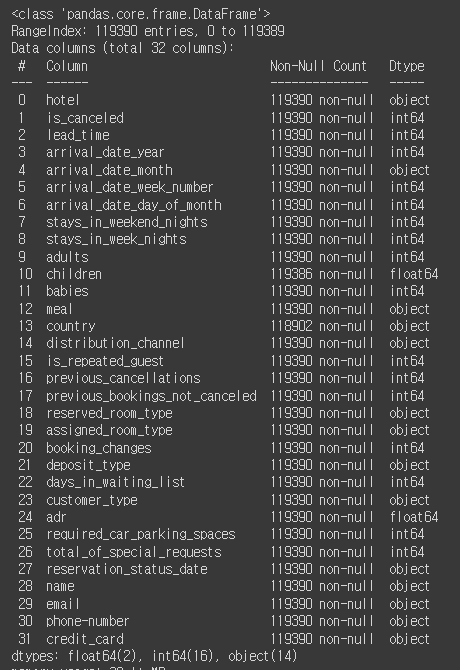
✅ 모델 학습에 필요 없는 피쳐 삭제하기
hotel_df.drop(['credit_card', 'name', 'email', 'phone-number', 'reservation_status_date'], axis=1, inplace=True)
✅ 수치형 컬럼의 정보 알아보기
hotel_df.describe()
✅ 예약 시점으로부터 체크인 될 때까지의 기간의 데이터가 얼마나 있는지 시각화해서 알아보기
sns.displot(hotel_df['lead_time'])
✅ 이상치 확인을 위해 boxplot으로 데이터 분포 알아보기
sns.boxplot(y=hotel_df['lead_time'])
✅ 예약 방법에 따른 취소여부의 데이터 수를 알아보기
sns.barplot(x=hotel_df['distribution_channel'], y=hotel_df['is_canceled'])
✅ 예약방법에 대하여 중복값을 제외한 데이터의 종류와 개수 알아보기
hotel_df['distribution_channel'].value_counts()
✅ 호텔 종류에 따른 취소 여부 알아보기
sns.barplot(x=hotel_df['hotel'], y=hotel_df['is_canceled'])
✅ 도착 예정 연도에 따른 취소 여부 알아보기
sns.barplot(x=hotel_df['arrival_date_year'], y=hotel_df['is_canceled'])
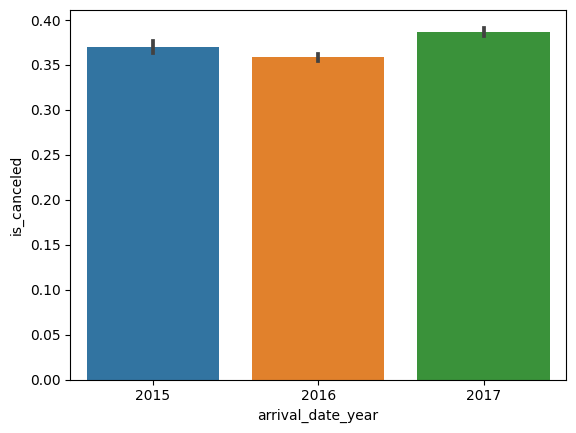
✅ 도착 예정 월에 대한 취소 여부 알아보기
plt.figure(figsize=(15,5))
sns.barplot(x=hotel_df['arrival_date_month'], y=hotel_df['is_canceled'])
✅ x축의 범위를 1월부터 12월까지 정렬하여 나타내기
import calendar
print(calendar.month_name[1]) # 1월에 있는 달에 대한 이름이 나옴
print(calendar.month_name[2]) # 2월에 있는 달에 대한 이름이 나옴
print(calendar.month_name[3]) # 3월에 있는 달에 대한 이름이 나옴
>>> January
February
March
# 월 별 이름을 담을 리스트
months = []
# 1~12까지 반복
for i in range(1, 13):
months.append(calendar.month_name[i])
months
>>> ['January',
'February',
'March',
'April',
'May',
'June',
'July',
'August',
'September',
'October',
'November',
'December']✅ x축의 범위에 months 리스트로 정렬하기
plt.figure(figsize=(15,5))
sns.barplot(x=hotel_df['arrival_date_month'], y=hotel_df['is_canceled'], order=months) # months(1~12월)의 순서대로 정렬
✅ 취소했다가 다시 예약한 적이 있는지에 대한 여부에 따른 취소 여부 알아보기
sns.barplot(x=hotel_df['is_repeated_guest'], y=hotel_df['is_canceled'])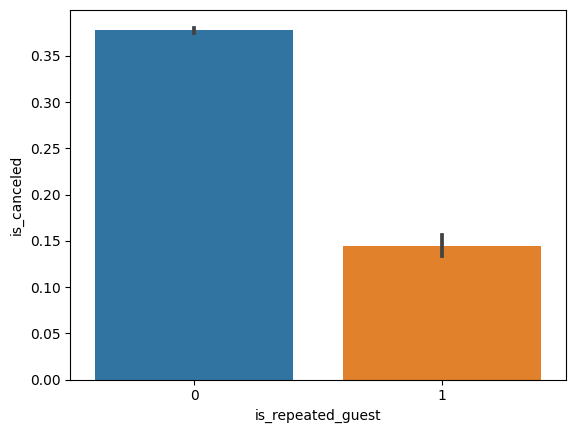
✅ 요금 납부 방식에 따른 취소 여부 알아보기
sns.barplot(x=hotel_df['deposit_type'], y=hotel_df['is_canceled'])
✅ 'deposil_type'의 중복값을 제외한 데이터와 데이터 개수 알아보기
hotel_df['deposit_type'].value_counts()
✅ 각 피쳐들간의 상관관계에 대해 알아보기 위해 heatmap 이용하기
sns.heatmap()
- coolwarm : 빨강, 파랑을 같이 쓰는 팔레트, 0보다 크면 빨강색, 작으면 파랑색으로 표시
- vmax/vmin: -1~1까지 값으로 정규화
- annot=True: 네모칸 안에 정규화 값을 작성
plt.figure(figsize=(15,15))
sns.heatmap(hotel_df.corr(), cmap='coolwarm', vmax=1, vmin =-1, annot=True)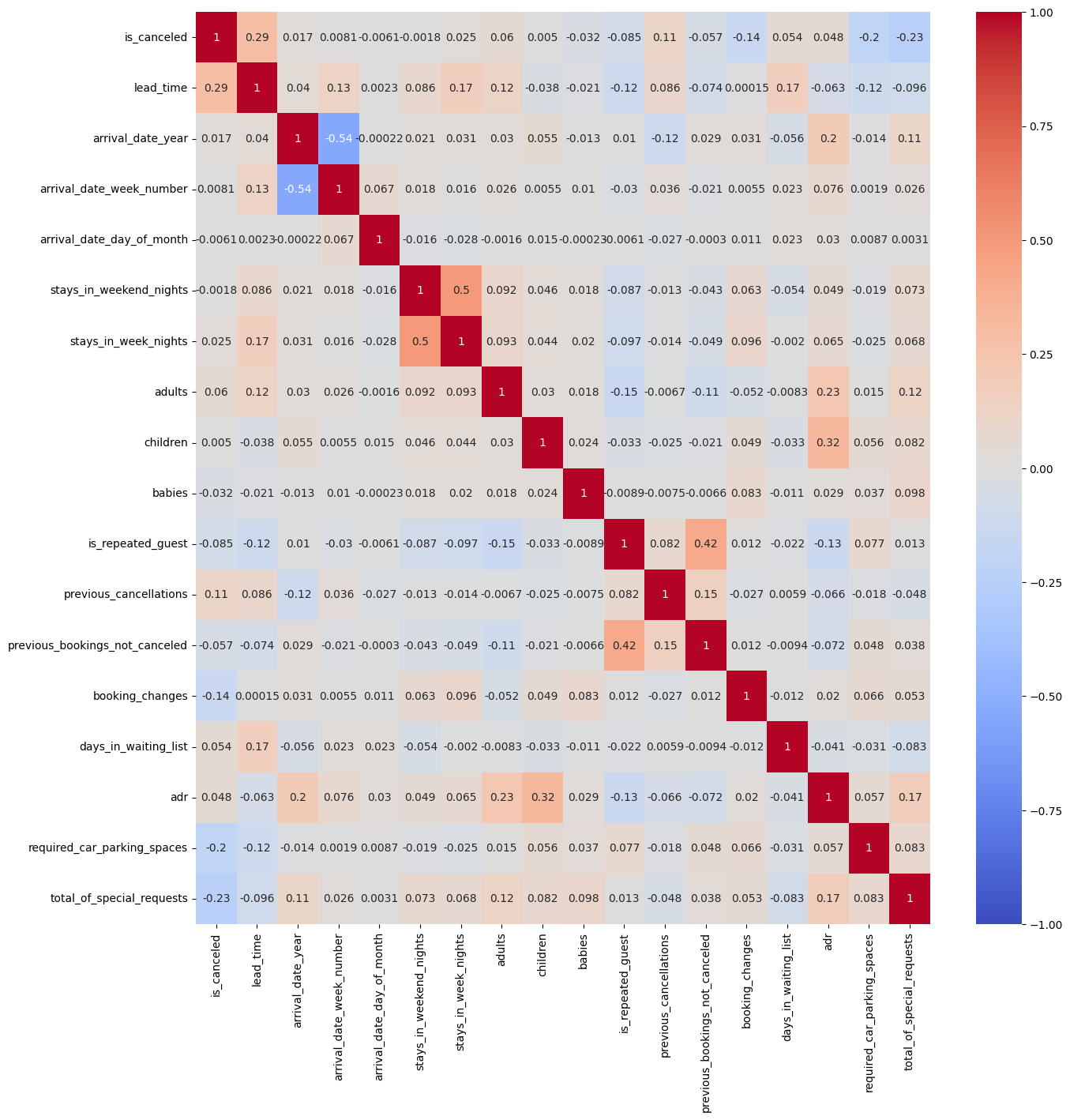
✅ hotel_df에 대한 정보 다시 알아보기
hotel_df.info()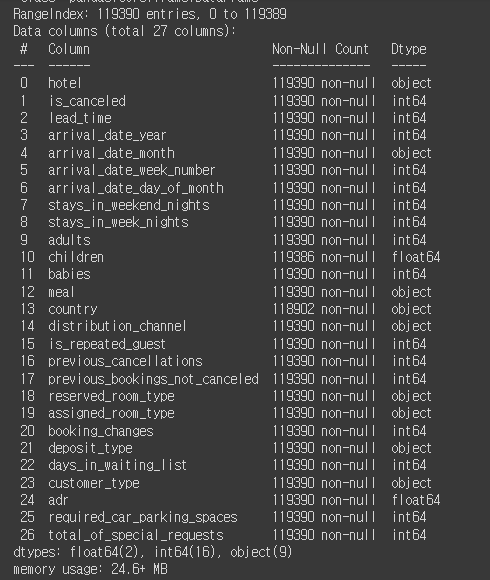
✅ NaN값의 비율이 작기 때문에 NaN값은 제거 후 재저장하기
hotel_df = hotel_df.dropna()
✅ 어른들이 없이 예약된 데이터 알아보기(adult의 값이 0)
hotel_df[hotel_df['adults'] == 0]
✅ 성인, 아이, 아기를 포함하는 인원수라는 파생변수를 만들
hotel_df['people'] = hotel_df['adults'] + hotel_df['children'] + hotel_df['babies']
hotel_df.head()
✅ 인원수가 0명인 데이터를 삭제하기
hotel_df[hotel_df['people']==0]
hotel_df = hotel_df[hotel_df['people']!=0] # 인원수가 0이 아닌 데이터만 저장
✅ 며칠을 묵었는지(total_nights)에 대한 파생변수를 만들기
hotel_df['total_nights'] = hotel_df['stays_in_week_nights'] + hotel_df['stays_in_weekend_nights']
✅ total_nights가 0인 데이터 알아보기
hotel_df[hotel_df['total_nights']==0]
✅ 계절에 따른 취소여부를 알아보기 위해 월을 기준으로 계절(season)이라는 파생변수를 만들기
hotel_df['arrival_date_month'].apply(lambda x: 'spring' if x in ['March', 'April', 'May'] else 'summer' if x in ['June', 'July', 'August'] else 'fall' if x in ['September', 'October', 'November'] else 'winter')
✅ dictionary를 이용하여 파생변수 만들기
season_dic = {'spring':[3,4,5], 'summer':[6,7,8], 'fall':[9,10,11], 'winter':[12,1,2]}
new_season_dic = {}
for i in season_dic: # season_dic의 길이만큼(4번) 반복하면서
for j in season_dic[i]: # 딕셔너리의 각 키에 대해 값들을 나타내는 리스트에 대해 반복문을 수행, j는 각 키값에 대한 value값을 나타냄
# print(j)
new_season_dic[calendar.month_name[j]] = i
new_season_dic
# map(): 시리즈(Series) 객체나 데이터프레임(DataFrame) 객체의 각 요소에 대해 지정된 함수를 적용하여 새로운 값을 반환하는 메서드
# new_season_dic 딕셔너리를 참조하여 해당하는 계절로 매핑
hotel_df['season'] = hotel_df['arrival_date_month'].map(new_season_dic)
hotel_df.head()
✅ 예약한 방의 타입과 배정된 방의 타입이 같으면 True, 아니면 False -> 0, 1로 변환하기
hotel_df['expected_room_type'] = (hotel_df['reserved_room_type'] == hotel_df['assigned_room_type']).astype(int)
✅ hotel_df 정보보기
hotel_df.info()
✅ 취소율(이전의 취소 횟수 / 취소된 횟수+취소안된 횟수) 파생변수 만들기
# 이전 예약에서 얼마나 많은 비율로 취소되었는지를 나타내는 지표
hotel_df['cancel_rate'] = hotel_df['previous_cancellations'] / (hotel_df['previous_cancellations'] + hotel_df['previous_bookings_not_canceled'])
✅ 취소율이 NaN인 데이터 ➡ 처음 방문한 사람들
hotel_df[hotel_df['cancel_rate'].isna()]
✅ 방문한 적은 있지만 취소한적이 없는 경우
hotel_df[~hotel_df['cancel_rate'].isna()]
✅ 취소한적이 한번이라도 있는경우
hotel_df[hotel_df['cancel_rate']>0]
✅ NaN의 경우 별도의 카테고리로 만들기 위해 -1로 채우기
hotel_df['cancel_rate'] = hotel_df['cancel_rate'].fillna(-1)
hotel_df.info()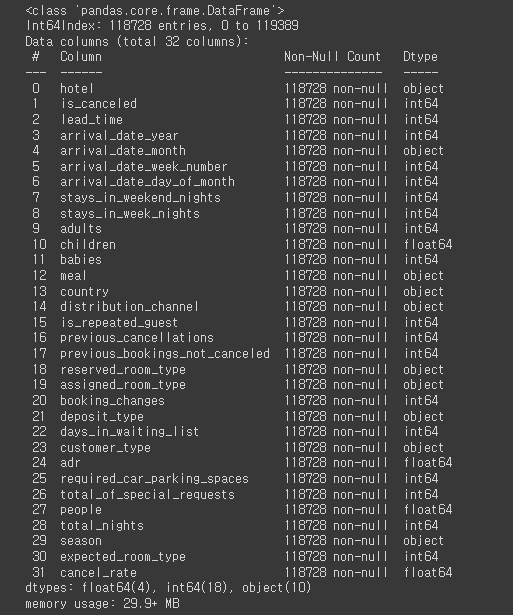
✅ country 열의 데이터 타입 알아보기
hotel_df['country'].dtype # dtype('O'): Object
>>> dtype('O')
✅ 'people' 열의 데이터 타입 알아보기
hotel_df['people'].dtype
>>> dtype('float64')
✅ 데이터 타입이 object 인 컬럼을 list에 추가하기
obj_list = []
for i in hotel_df.columns:
if hotel_df[i].dtype == 'O': # 컬럼들 중 dtype이 'O'인 경우
obj_list.append(i) # 리스트에 추가
✅ 데이터 타입이 object인 컬럼의 중복값을 제외한 데이터의 개수 알아보기
for i in obj_list:
print(i, hotel_df[i].nunique())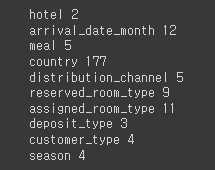
✅ 'meal' 열의 중복값을 제외한 데이터와 개수 알아보기
hotel_df['meal'].value_counts()
✅ country와 meal 열을 제거
hotel_df.drop(['country', 'meal'], axis=1, inplace=True)
✅ obj_list에서도 제거
obj_list.remove("country")
obj_list.remove("meal")
✅ 원핫인코딩 하기
hotel_df = pd.get_dummies(hotel_df, columns=obj_list)
hotel_df.head()
✅ 학습데이터와 검증데이터 분리하기
from sklearn.model_selection import train_test_splitX_train, X_test, y_train, y_test = train_test_split(hotel_df.drop('is_canceled', axis=1), hotel_df['is_canceled'], test_size=0.3, random_state=10)2. 랜덤 포레스트(Random Forest)
- Decision Tree는 매우 훌륭한 모델이지만 학습 데이터에 오버피팅(과대적합) 하는 경향이 있음(가지치기 같은 방법을 통해 부작용을 최소화할 수 있지만 부족함)
- 학습을 통해 구성해 놓은 다수의 나무들(Decision Tree)로 부터 분류 결과를 취합해서 결론을 얻는 방식의 모델
- Decision Tree 기반의 Bagging 앙상블 모델
- 굉장히 인기 있는 모델이며, 사용성이 쉽고 성능도 꽤 우수한편
2-1. 앙상블(Ensemble) 모델
- 여러개의 머신러닝 모델을 이용해 최적의 답을 찾아내는 기법
1) 보팅(Voting)
- 다른 알고리즘 model을 조합해서 사용
- 모델에 대해 투표로 결과를 도출
- 분류를 할 때 voting이라는 하이퍼 파라미터를 사용
2) 배깅(Bagging)
- 같은 알고리즘 내에서 다른 sample 조합을 사용
- 샘플 중복 생성을 통해 결과를 도출
- 여러개의 dataset을 중첩을 허용하여 샘플링하고 분할하는 방식
3) 부스팅(Boosting)
- 이전 오차를 보완해가면서 가중치를 부여
- 성능이 매우 우수하지만, 학습을 여러번 하기 때문에 잘못된 레이블이나 아웃라이어에 대해 필요 이상으로 민감(데이터가 한쪽으로 쏠려서 아웃라이어쪽으로 학습하게 되면 이상한 결과가 도출될 수 있음)
4) 스태킹(Stacking)
- 여러 모델을 기반으로 예측된 결과를 통해 meta 모델(성능 좋은 모델)이 다시 한번 예측
- 성능을 극으로 끌어올릴 때 활용하지만 과대적합을 유발할 수 있음(특히 데이터셋이 적은 경우)
✅ 랜덤 포레스트 분류 실습
from sklearn.ensemble import RandomForestClassifier
# 객체 생성
rf = RandomForestClassifier()
# 학습
rf.fit(X_train, y_train)
# 예측
pred1 = rf.predict(X_test)
pred1
>>> array([0, 0, 0, ..., 0, 0, 0])
# 분류된 클래스 가능성
proba1 = rf.predict_proba(X_test)
proba1
>>> array([[1. , 0. ],
[1. , 0. ],
[0.73, 0.27],
...,
[1. , 0. ],
[0.88, 0.12],
[0.97, 0.03]])
# 첫번째 테스트 데이터에 대한 예측 결과
proba1[0]
>>> array([1., 0.])
# 모든 테스트 데이터에 대한 호텔 예약을 취소할 확률만 출력
proba1[:, 1] # 모든행, 1번열
>>> array([0. , 0. , 0.27, ..., 0. , 0.12, 0.03])3. ROC Curve
- 이진 분류의 성능을 측정하는 도구
- 민감도와 특이도로 그려지는 곡선을 의미
- FPR(False Positive Rate)
- 특이도(거짓 양성 비율)
- FP / TN + FP
- 실제값은 음성이지만 양성으로 잘못 분류
- TPR(True Positive Rate)
- 민감도(참인 양성 비율)
- TP / FN + TP
- 실제로 양성이고 양성으로 분류

4. AUC(Area Under th ROC Curve)
- ROC 커브와 직선 사이의 면적을 의미
- AUC값의 범위는 0.5 ~ 1이며, 값이 클수록 예측의 정확도가 높음
from sklearn.metrics import accuracy_score, confusion_matrix, classification_report, roc_auc_score
accuracy_score(y_test, pred1)
>>> 0.8642297650130548 # 데이터가 한쪽으로 쏠리진 않음
# 혼돈 행렬
confusion_matrix(y_test, pred1)
>>> array([[20821, 1537],
[ 3299, 9962]])
# 리포트로 보기
print(classification_report(y_test, pred1))
# roc_auc_score(모든 데이터에서 참일 확률을 넣어야함!)
roc_auc_score(y_test, proba1[:,1])
✅ 하이퍼 파라미터 튜닝 - max_depth=30을 적용했을 때
rf2 = RandomForestClassifier(max_depth=30, random_state=10)
rf2.fit(X_train, y_train)
proba2 = rf2.predict_proba(X_test)
roc_auc_score(y_test, proba2[:, 1])
>>> 0.9320285483491656
✅ 하이퍼 파라미터 튜닝 - max_depth=50을 적용했을 때
rf2 = RandomForestClassifier(max_depth=50, random_state=10)
rf2.fit(X_train, y_train)
proba2 = rf2.predict_proba(X_test)
roc_auc_score(y_test, proba2[:,1])
>>> 0.9303745518246758
✅ 하이퍼 파라미터 튜닝 - min_samples_split=5 로 적용했을 때
rf2 = RandomForestClassifier(min_samples_split=5, random_state=10)
rf2.fit(X_train, y_train)
proba2 = rf2.predict_proba(X_test)
roc_auc_score(y_test, proba2[:,1])
>>> 0.931436154565479
✅ 하이퍼 파라미터 수정 - min_samples_split=7 로 적용했을 때
rf2 = RandomForestClassifier(min_samples_split=7, random_state=10)
rf2.fit(X_train, y_train)
proba2 = rf2.predict_proba(X_test)
roc_auc_score(y_test, proba2[:,1])
>>> 0.9312578210627522
✅ 튜닝 후 정확도 비교
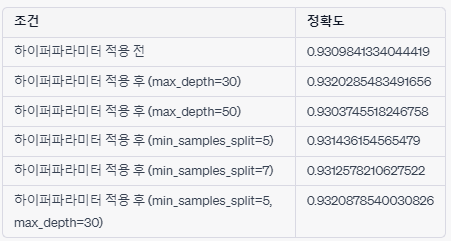
✅ 하이퍼 파라미터 최적의 값 적용
rf2 = RandomForestClassifier(min_samples_split=5,max_depth=30, random_state=10)
rf2.fit(X_train, y_train)
proba2 = rf2.predict_proba(X_test)
roc_auc_score(y_test, proba2[:,1])
>>> 0.9320878540030826
1. 하이퍼 파라미터에 넣는 속성을 콜라보했을 때 무조건 성능이 좋아지지 않는다.
2. 하이퍼 파라미터의 주로 사용되어지는 하이퍼 파라미터의 주어지는 값의 범위를 알고있을 필요가 있다.
5. 하이퍼 파라미터 최적의 값을 찾는 방법
- GridSearchCV: 원하는 모든 하이퍼 파라미터를 적용하여 최적의 값을 찾음
from sklearn.model_selection import GridSearchCV
params = {
'max_depth': [None, 10, 30, 50], # 범위값을 지정
'min_samples_split': [2, 3, 5, 7, 20]
}
# 객체 생성
rf3 = RandomForestClassifier(random_state=10)
# 최적의 하이퍼 파라미터를 찾는 객체 생성
grid_df = GridSearchCV(rf3, params, cv=5) # cv: 데이터 교차검증 수
# 학습
grid_df.fit(X_train, y_train)
# best_params_: 최적의 성능을 만들 하이퍼 파라미터를 알려줌(params로 설정해놓은 범위 내에서)
grid_df.best_params_
# 최적의 하이퍼 파라미터 적용
rf3 = RandomForestClassifier(min_samples_split=3,max_depth=30, random_state=10)
rf3.fit(X_train, y_train)
proba3 = rf3.predict_proba(X_test)
roc_auc_score(y_test, proba3[:,1])
>>> 0.93222376946864476. 피쳐 중요도
- Decision Tree에서 노드가 분기할 때 해당 피쳐가 클래스를 나누는데 얼마나 영향을 미쳤는지 표기하는 척도
- 0 이면 클래스를 구분하는데 해당 피쳐가 선택되지 않았다는 것이며, 1이면 해당 피쳐가 클래스를 완벽하게 나누었다는 것을 의미
- normalized ndarray 를 리턴시켜줌(0 ~ 1의 수, 합이 1이 됨)
- 이 프로젝트에서 중요도를 알려주는 지표로 사용될 수 있음
proba3 = rf3.predict_proba(X_test)
proba3
>>> array([[0.99 , 0.01 ],
[0.98278521, 0.01721479],
[0.6161123 , 0.3838877 ],
...,
[1. , 0. ],
[0.92583825, 0.07416175],
[0.9605 , 0.0395 ]])
# roc_auc_score
roc_auc_score(y_test, proba3[:,1])
>>> 0.9322237694686447
# 첫번째 feature는 0.1223~만큼의 가중치를 가짐(중요도가 12% 정도)
rf3.feature_importances_
✅ 피쳐중요도를 데이터프레임으로 만들기
feat_imp = pd.DataFrame({
'features': X_train.columns,
'importances':rf3.feature_importances_
})
feat_imp
✅ 가장 영향력 있는 feature 10개를 뽑아보기
top10 = feat_imp.sort_values('importances', ascending=False).head(10)
top10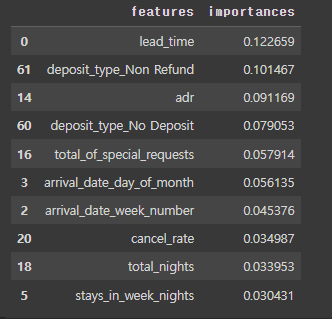
✅ top10 그래프로 그려보기
plt.figure(figsize=(5,10))
sns.barplot(x='importances', y='features', data=top10)

'Python > ML&DL' 카테고리의 다른 글
| [파이썬, Python] 머신러닝 - 7️⃣ KMeans (0) | 2023.06.19 |
|---|---|
| [파이썬, Python] 머신러닝 - 6️⃣ LightGBM (0) | 2023.06.18 |
| [파이썬, Python] 머신러닝 - 4️⃣ 서포트 벡터 머신(Support Vector Machine) (0) | 2023.06.18 |
| [파이썬, Python] 머신러닝 - 3️⃣ 로지스틱 회귀(Logistic Regression) (0) | 2023.06.15 |
| [파이썬, Python] 머신러닝 - 2️⃣ 의사결정나무(Decision Tree) (2) | 2023.06.14 |



